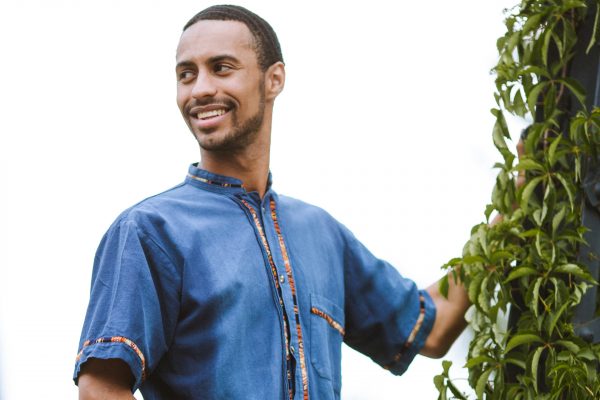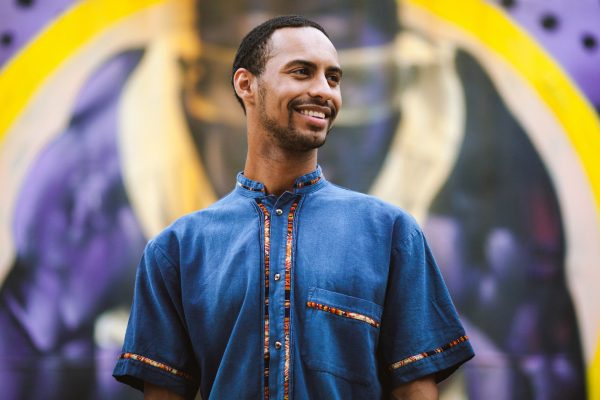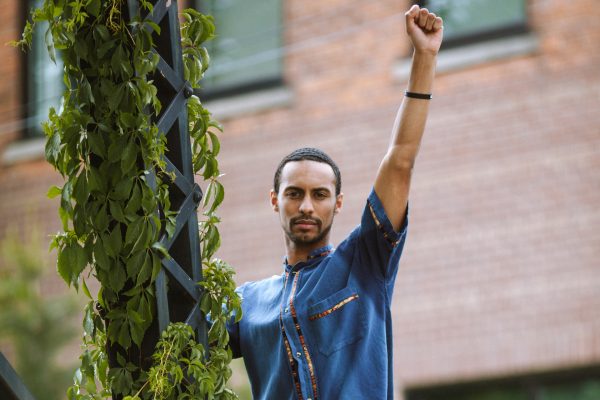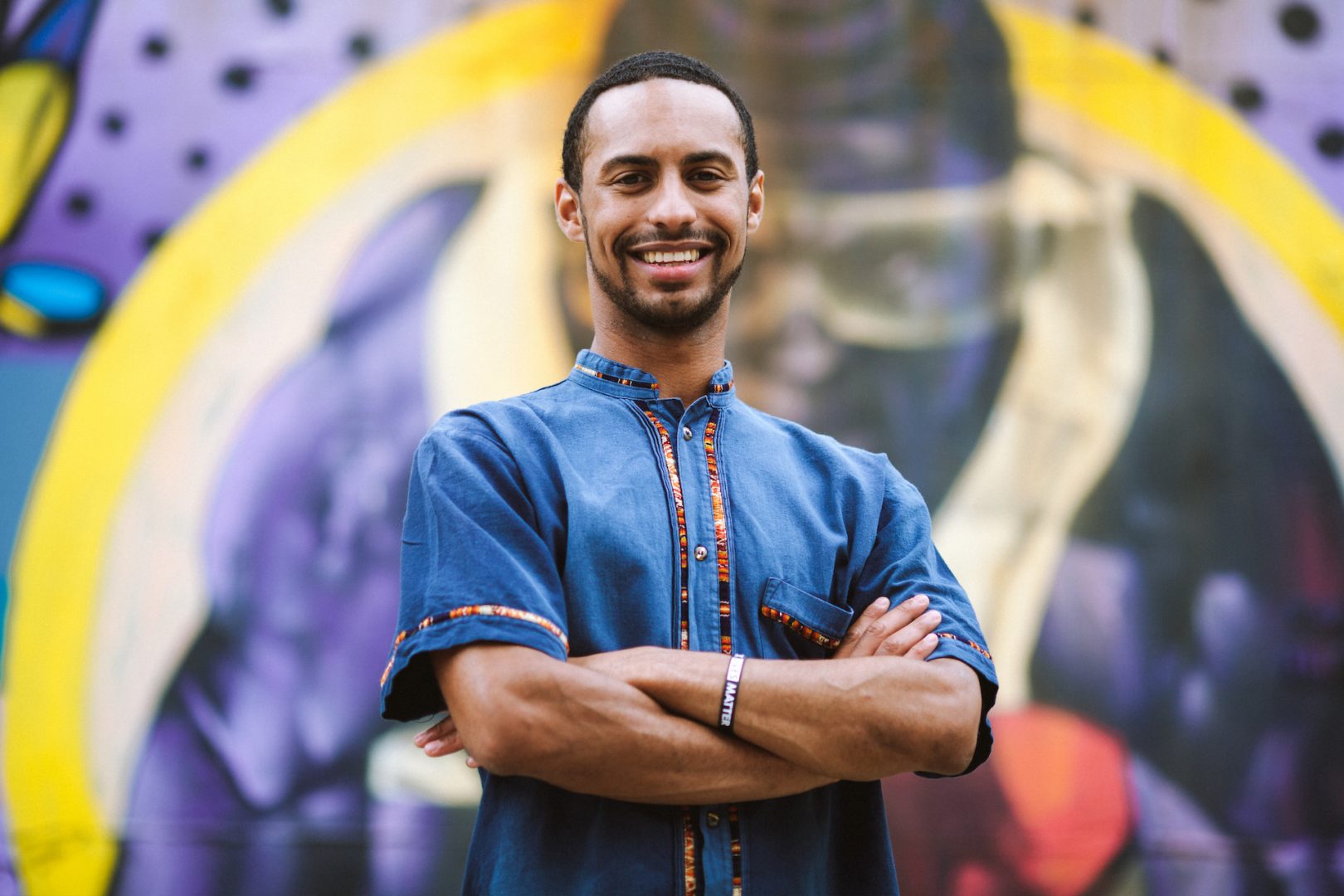By Meghan Yuri Young Photography by Max Power Theatre creator and activist Donovan Hayden blends the art of performance with powerful messages of Black liberation that inspire and challenge. June 2023 Update: In our interview,…
By NowPlayingToronto
By Meghan Yuri Young
Photography by Max Power
June 2023 Update: In our interview, Donovan mentions his debut play, which is no longer being staged. However, it’s an important part of his story as a theatre-maker. After you learn about Donovan and trajectory, browse our event listings of upcoming stage productions.
Donovan Hayden is an intersection of interests. It’s almost as if he’s personifying one of his favourite places in the city: the West Toronto Railpath. Like the multi-use trail — with its railways and bridges against a backdrop of greenery and graffiti — the theatre creator and activist speaks to a multitude of topics. Art, performance, community, representation, and more converge. But Donovan also moves well beyond just speaking about these topics. Impact is at the forefront of what he does, whether it’s his dedication to social justice or using theatre as a vehicle to deliver powerful messages of anti-racism. That commitment to blending theatre and activism poignantly merged in Donovan’s play X and Da Spirit, which made its debut at the 2022 Fringe Festival.

Meghan Yuri Young (MYY): Donovan, thank you for bringing us to a hidden Toronto gem for this interview! Why did you choose the Toronto Railpath?
Donovan Hayden (DH:) I grew up just west of here, and now, I live just east of here. So, it’s always a nice little middle ground. I would go on a lot of walks, especially during the pandemic, and I always appreciated spots with lots of graffiti. I noticed all these murals and all the, like, quick BLM tags. They had an Audre Lorde mural, a Coretta Scott King one, an Angela Davis one and, of course, the one that’s behind us, Jesse Owens. And I was like, “Man, this is not only a nice spot, but I’m also surrounded by all these Black icons.” So, of course, I’m gonna come here as often as I can. It was a great place to clear my head, but also a great place to meet friends. It’s just a great spot to do so many different things.
MYY: I feel like everything within this intersection of paths and roads represent intersections of your interests. But before we get into that, can you introduce yourself and what you do?
DH: My name is Donovan Hayden. I’m a Black theatre creator and activist. I just am trying to figure out a way to blend theatre and activism to create pieces of art that are inspirational and challenge systems, and that bring people in who aren’t often brought in.
MYY: That’s beautiful. Have you explored other art forms, or was theatre always your calling?
DH: Well, I’m bad at visual arts. I can’t draw a smiley face. I can’t even do a circle. I can carry a tune but I’m not a singer. I wish I was, or a rapper! Ooh, that’d be perfect. But, I think theatre really called me. It’s live, it happens right in front of you, you can’t pause it. It was so powerful to me that, on any given night, I’m going to have a group of people focused on what I’m creating or what I’m in. Theatre grabs you in ways that a screen, or even just listening, doesn’t. You can feel the breadth of the actors because they’re in the same space as you.
I came from a social justice background. The protests, the graffiti — it’s all about what would be the most impactful on audiences. For me, it was theatre because it’s right in front of you. There’s nowhere to go, and you really connect with it in a very personal way.
 MYY: You mentioned that you come from a social justice background. Is that what you studied in school or did you double major, for instance, in both theatre and social justice?
MYY: You mentioned that you come from a social justice background. Is that what you studied in school or did you double major, for instance, in both theatre and social justice?
DH: I double majored in sociology and Black studies. I came across theatre in my second year of university. I was in plays, I was in a theatre troupe, I would write. I wrote a play in my senior year, but yet never declared a theatre major. I always joked with actual theatre people that I’m the most theatre non-theatre major. To me, theatre has always been more so the tool to do a lot of my social justice work.
I love theatre, and I’ve really grown appreciation for it, but the type of stuff I do isn’t just to entertain. It isn’t just to spend two hours, or whatever, having a laugh or a cry. It’s a way to spread a message. A lot of my sociology professors were like, “Donovan, what are you doing? Theatre?” I was like, “Hey, I am doing sociology through theatre.” I’m studying how people move. Especially in my Black studies — they called it Africana studies — it was like, “Look what I’m writing about! I’m writing about us. I’m using our art forms. I’m researching some of the old Black playwrights, like Amiri Baraka.” I was doing sociology and I was doing Africana studies, just on stage.
MYY: That’s creative thinking right there. Instead of honing all of your time and energy into theatre, theatre is complimenting these other integral points of interest for you, which then inform your art craft.
DH: I think it’s so important, especially if I am going to be someone who’s making a lot of Black art and socially conscious art. We need to be grounded in the communities we’re representing and in that struggle. I’ll go to a few plays and I’ll be like, “Okay, that was entertaining. But I can tell you’ve never been to a protest. I can tell that you have never struggled in those ways.”
I’ve definitely dealt with racism, but I had a lot of economic privilege. So, it was really important that I’m also grounding myself in that [struggle] — and not just assuming that I can speak for or on it.
MYY: Speaking of studies, correct me if I’m wrong, but I read that you went to school in both New York and Pittsburgh.
DH: I love people having to figure out where I’ve been because there’s been a lot of back and forth. I lived in, and went to school in, both those cities. Essentially, I’ve been going back and forth from the States all my life. I was born in Guelph then I moved to Pittsburgh when I was one. When I was 10, I moved to Toronto. When I was 17, I moved back to Pittsburgh and did my senior year of high school there. Then, I went to Hobart and William Smith Colleges in Geneva, New York. I did the four years there, but on breaks, I’d come back up here. My parents were back up in Toronto. After I graduated university in New York, I went to Pittsburgh for one year. Then, I came back here.
MYY: So, you not only went to school elsewhere, you have real roots there, especially in Pittsburgh. What brought you back to Toronto?
DH: Really, the technical reason is that I was going to graduate from York University. But what keeps me here is that there’s just so much theatre and also how dynamic the city is. I mean, I love Pittsburgh, may eventually make that my home, but you can’t trip over a theatre company there.
There’s just so much arts here. I have so many networks that I’ve really learned from and rely on. I also think there’s a certain thing I love about the accessibility of the city, just, like, physically in that Pittsburgh doesn’t have great public transit and those hills are wild. My calf muscles definitely got a nice workout when I was there. So, I love that I can just skip across [Toronto] and go to different places.
But the big thing, for me, which drew me to Toronto is that a lot of the work I was doing around race was so much more important here. I felt like I was making more of an impact. There’s a lot of organizations, a lot of activists, a lot of big discussions on Blackness that can be pretty inaccessible, especially if you’re newer, younger. But, here, these conversations feel fresh. We are at a point where it’s now an okay opinion to say that anti-Black racism exists. Pre-2020, I’d have people fighting me on that. We like to say, “Oh, Canada’s so great,” but it’s in its infancy of a real movement. That’s exciting in Toronto.
 MYY: That’s amazing that you’re excited to be part of that learning curve, and that you have the energy to help. Speaking of accessibility, tell me a little bit about your relationship with the Fringe Festival, where you staged your play X and Da Spirit in 2022.
MYY: That’s amazing that you’re excited to be part of that learning curve, and that you have the energy to help. Speaking of accessibility, tell me a little bit about your relationship with the Fringe Festival, where you staged your play X and Da Spirit in 2022.
DH: When I started getting into theatre in university, I realized, “Wait a second, if I’m doing theatre, I can also go to theatre.” I was really excited to go to a lot of things, but so many shows are just so unaffordable for a student. But I could come to Toronto and see shows for a little over $10. So, that’s really where I started with Fringe — as an audience member. I couldn’t afford to go to a lot of shows, but I’d get the five- or six-show pass and I’d watch what I could. I was always amazed at the diversity of what I was seeing. There were some productions that really stayed with me. Some were very traditional by, you could tell, established theatre creators. Some were just like, “I can’t quite tell you what happened, but something wild just happened on stage.”
Fringe is a really great place for people who either want to do theatre, or just have an idea to put their name in the lottery and be able to make a show. People would always tell me, especially when I started writing, “Oh, you should try to get your shows into Fringe.” I didn’t really think too much of it until I realized it was a lottery system. I was definitely like, “That’s just not gonna happen, just pick your name outta the hat and be Lucky Number 270, or whatever.” But I did put my name in the hat, knowing all the while I wasn’t gonna be in Fringe.
Then, the day they’re announcing the lottery winners, I have it in the background as I’m doing work. Suddenly, I’m hearing my name: “Welcome, Donovan, to the Fringe.” And I was like, “Why are you talking about me? Well, it must be another Donovan.” Then I look and see, “Donovan Hayden, Deconstruction Productions.” And I was like, “This doesn’t make any sense!” There are over 200 names in this category, and they were taking only, like, 19 people. I should have bought an actual lottery ticket that day. It was wild.
MYY: Wow, I can’t imagine the emotions that were running through you!
DH: I was really happy to be doing it, but I was scared and nervous as hell as well. Of course, this is the first show that [I produced] for a wider audience that isn’t just for friends, family, and college students. It was definitely like, “Oh, I’m really gonna have to manage a budget, find a team, take criticism.”
MYY: Can you share a little bit about that production?
DH: Of course! The play is called X and da Spirit. It’s a semi-autobiographical story about coming of age in the summer of 2020 as a young Black activist. It came out of my graduate studies. I’d done a lot of activism in Pittsburgh, and then I moved up here and the scene was very different. In Pittsburgh, they’re protesting every single day. So, there was always something to do. I came here, and we’d have a protest a week in two-hour blocks. It was fine, just very different. So, I felt very disconnected. I also didn’t know a lot of the networks that I have now.
But I came across a mural that was at Nordheimer Ravine, and I was just amazed at this thing. I mean, it was massive and it didn’t have the typical “I can’t breathe” or “Black Lives Matter” rhetoric. Instead, the artist built the whole mural with the names of people killed by police and took the time to write each of these names. As I’m looking at this masterpiece, I start wondering, “Where’s the name of the artist? Who did this? Who’s gonna get credit?” There’s no name. The only names are the people who were murdered by police. Luckily, I was able to connect with the artist a year later. He’s actually helping us with the show and recreating the mural for the show.
All I could think when I found that mural is, “This is a special place. This is a real special place. And I feel something here. I don’t know what I feel, but I feel it.” Whenever I don’t know what I’m feeling, I turn to writing and to theatre. So, I was like, “Let me create this story, this journey about being drawn into this struggle. The spirit of the struggle.”
MYY: What are you hoping people took from the play?
DH: In the context we’re in now, I wanted people to walk away thinking, “It’s not over.” I mean, look at where we are. They’ve covered up most of those BLM murals, which is fine. Art covers over itself. But I think we’ve forgotten that Black lives continue to matter, that we are still organizing, that we need support, that — even though the names of people getting killed are no longer on our TV screens or on our Instagram pages — it’s still happening. Even when we do reach a certain amount of success, we still have to deal with certain amounts of racism.
And, we knew it was coming. We knew in 2020 that, frankly, white folks weren’t gonna care forever. And, as we see now, they’ve moved on to other things. But we’re still here. We’re still organizing and we’re gonna keep fighting. And, if you want to sit there as an audience member and be like, “Great performance, love it. Now, let me go back to whatever I was doing before,” that’s on you. But my hope is that you feel an obligation to join the struggle and, hopefully, you feel the spirit as well.
 MYY: That’s so beautifully powerful. I also love that art inspired your art, and that that artist is recreating his mural for your play. That leads into my next question, what does Toronto mean to you?
MYY: That’s so beautifully powerful. I also love that art inspired your art, and that that artist is recreating his mural for your play. That leads into my next question, what does Toronto mean to you?
DH: In all the places I’ve lived, there’s a quality about those cities that I can see in myself. Toronto has made me dynamic, has made me have a certain amount of hunger to do well. It has also given me a certain amount of tunnel vision at times. For a city of five million people, it’s amazing how many of us are focused on one thing in front of us at all times, and everything else is just a distraction that needs to be stopped.
MYY: How does Toronto inspire you as an artist?
DH: I really enjoy just moving around the city, especially around Black hubs, or even some that used to be Black hubs, like Bathurst and Bloor, or up at Little Jamaica. I used to live closer to Jane Street. So, Jane and Lawrence, I love being in those spaces. Having grown up in the very white communities of Toronto, it was always nice to break out of that. I don’t really have particular places that draw me in though. I just really love being in the busy parts of Toronto. It’s not a popular feeling right now, but I love being in a crowd.
MYY: Are there any hidden gems that stick out for you, outside of the Railpath?
DH: On a very simple level, in terms of food, there’s a pizza spot called Chitos Pizza. They keep the prices low, and that’s the big thing. They have one pizza with shawarma on top. It’s unreal.
The other thing I got to shout out are the libraries. Especially when I was working from home or writing from home a lot, I’d go to the library every day and write. The libraries, to me, are just great spaces to be in, being around books, being around more people. They’re also a reminder of why I do this work.
The Toronto Fringe Festival, where Donovan’s play became a 2022 Patron’s Pick — an honour determined by ticket sales — happens each year. And, over on our blog, we’ve taken the guesswork out of finding intimate and independent live theatre in Toronto.

